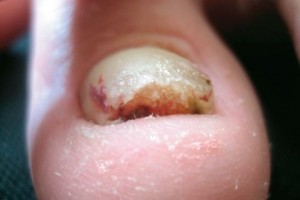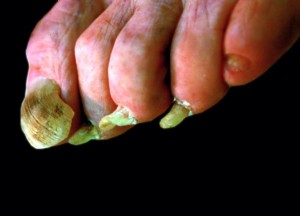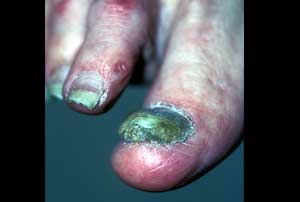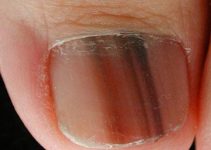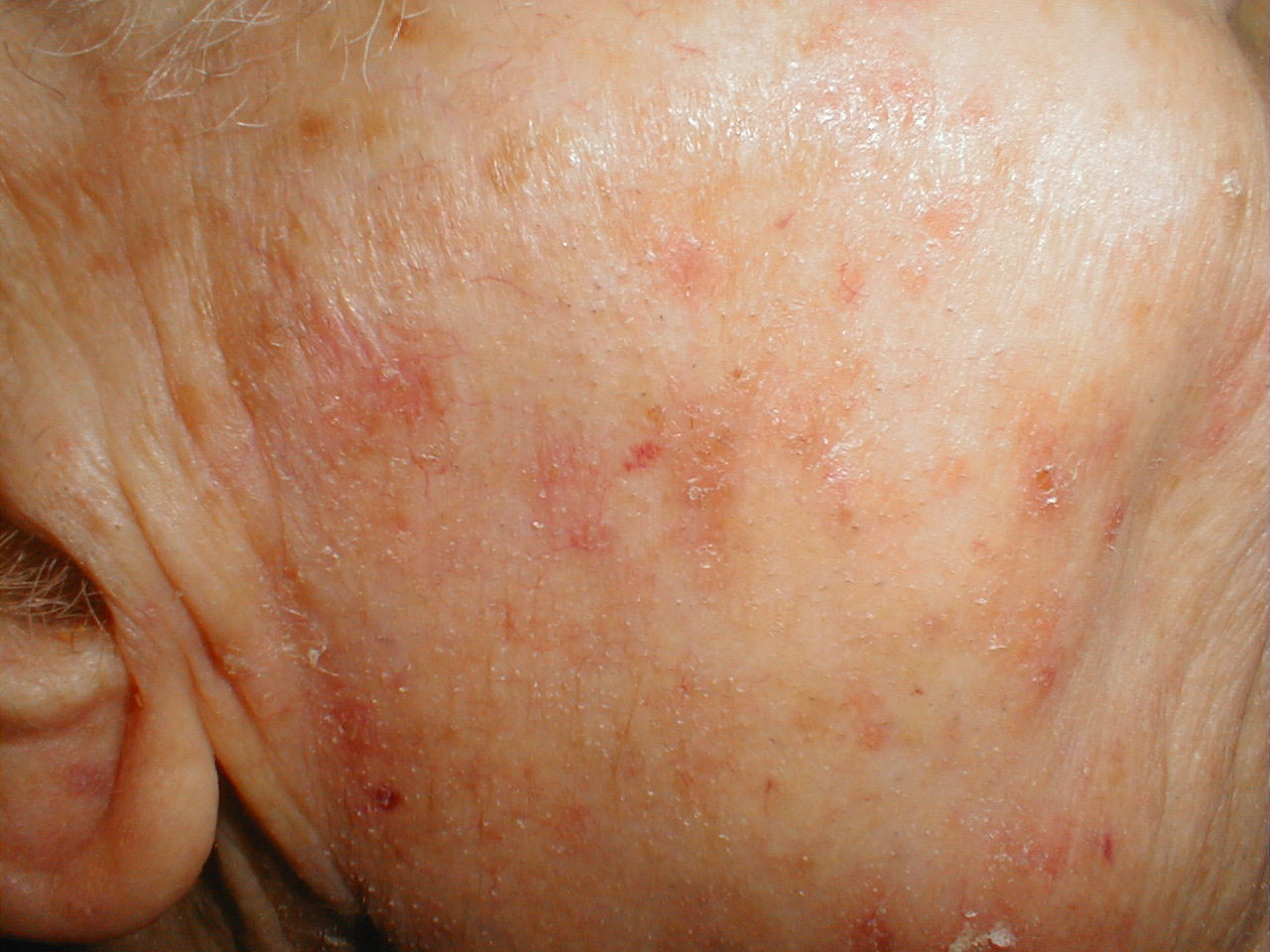Are you suffering an unusual thickness in your nails of late? You may be having a condition called Onychauxis. Read on to know what is Onychauxis, what causes it and what its symptoms and treatment are.
Picture 1 – Onychauxis
Source – nailsmag
Onychauxis Definition
Page Contents
Onychauxis is a health condition marked by a thickening of the nails. It is observed both in nails of the fingers and the toes. The disease is more common in older people than young ones.
Onychauxis is also known as Hypertrophy of the nail.
Onychauxis Symptoms
The most obvious symptom of Onychauxis is an abnormal thickening of the nail plate in the finger or toe. The nails usually thicken on the upper part. These can become white or yellowish in some patients with the nail edges falling apart.
The thick nails become quite difficult to trim uniformly and safely. The difficulty makes affected individuals leave the nails untouched until they grow out and curl by themselves. Left untreated the nail may also become discolored and may turn white, black, yellow or red.
Onychauxis Hypertrophy of the fingernail or toenail may occur in any single direction or in all directions.
Onychauxis Causes
Onychauxis can result from a number of reasons, such as :
Diabetes
Diabetic patients are often seen to suffer from this disease which makes medics suspect diabetes to be a cause of Onychauxis.
Impaired Circulation
Onychauxis can also arise from impaired blood circulation in the hands and feet. Lack of proper blood supply fails to provide the nails with enough nutrients necessary for its growth and maintenance.
Psoriasis
Psoriasis is a chronic skin disease that gives rise to red patches over various regions of the body. It is thought to lead to nail problems like Onychauxis.
Trauma
Trauma to the nails can also result in Onychauxis. This is particularly seen in people who wear very tight footwear. Compact shoes or slippers can put fingers of the toe under extreme pressure and give rise to Onychauxis.
Infection
Yeast or Fungal infection in the nail bed or the areas surrounding the nail plate can also cause Onychauxis.
Acromegaly
This condition leads to enlargement of bones in hands, feet and face. Acromegaly is also held responsible for the appearance of this nail disease.
Darier’s Disease
This genetic skin disorder gives rise to white lesions in the oral regions like palate and tongue.
Pityriasis Rubra Pilaris
This chronic disorder gives rise to reddish-orange blotches, flakes and thick bumps on the skin apart from other complications. It is supposed to be another reason behind Onychauxis.
Heredity
In some cases, hereditary factors can also be blamed for cases of Onychauxis. People with one or both parents suffering from Onychauxis can also suffer from it at some point their lives.
Onychauxis Treatment
The quickest and most popular method for treating this condition involves trimming the nails. Proper trimming will make the pain subside and provide space to nails to grow from the base. Frequent trimming can give a neat appearance to the nails and keep them in good shape. It will also remove the overgrown nail and make space for new nail to grow from the base.
Treatment of Onychauxis actually involves detecting the exact cause behind the condition. If the condition is found to result from diseases like Diabetes and Psoriasis, managing or curing the disorders can bring about an improvement in the nails.
In extreme cases of Onychauxis, a partial or complete removal of the affected nail may be required.
Onychauxis Home Remedy
Onychauxis cure can also be brought about with the help of home remedies like
Change of Footwear
If the disease is found to affect toenails as a result of wearing tight shoes, it is necessary to change footwear. Any footwear that is light and provides ample space to toenails should be opted for. It will keep the feet comfortable and also ensure wellness of nails.
Dietary Modifications
Onychauxis resulting from poor nourishment can be corrected by making changes in the diet. A proper diet can provide the body with essential nutrients and cure nail abnormalities resulting from lack of essential foods. Adding tomatoes, cabbages, oranges, cauliflowers, broccolis, cantaloupes, red peppers, grapefruits, strawberries and other Vitamin C-rich foods into the diet can help nails a lot.
Exercise
Impaired blood circulation in limbs can be improved by regular exercise. Daily workouts can make heart pump more blood into all the regions of the body and bring about an improvement in blood circulation.
How To Hide Onychauxis Nails?
Onychauxis nails can look quite unpleasant. You can hide the condition by applying clear varnish over the nail. This will help mask the abnormalities over the nail surface and make it look normal to casual viewers.
Onychauxis Appearance
In most patients, Onychauxis nails look discolored and broken around the edges. In patients with Onychauxis brittle nails is also observed often. This mainly happens due to underlying conditions like Psoriasis. In untreated Onychauxis, nails can become long and curved.
Onychauxis Prevention
Onychauxis of the nails can be prevented by following a few simple steps at home.
Proper Nail Trimming
Trim your toenails straight across the upper edge rather than making them round at the top. The rough edges should be smoothened with a file.
Wear Light Shoes
Wear shoes that provide enough space for your toes to breathe. Try wearing open-toed sandals from time to time. This will give space to your toenails and let them grow easily. Sports activities should be, however, carried out in closed finger shoes. An injury to the nails can also lead to Onychauxis.
Onychauxis Pictures
Want to know how Onychauxis nails look like. Here are some useful Onychauxis pictures that will help you get a clear idea about the appearance of the condition.
Picture 2 – Onychauxis Picture
Source – galleriapod
Picture 3 – Onychauxis Photo
Source – handandfootclinic
If you are having Onychauxis or finding any family member to be affected by this condition, it is better to seek early treatment. Early medical assistance will help you avoid a lot of discomforts and complications in the near future. In any case, it is better not to delay treatment where the safety of the health can be compromised.
References:
http://www.wisegeek.com/what-is-onychauxis.htm
http://en.wikipedia.org/wiki/Onychauxis
http://www.nuricare.com/en/services/details/22/5/Nail-abnormalities/Onychauxis
http://www.nailsmag.com/encyclopedia/64071/onychauxis-or-hypertrophy
http://www.enotes.com/topic/Onychauxis
http://www.nailsmag.com/article/82023/what-is-onychauxis

